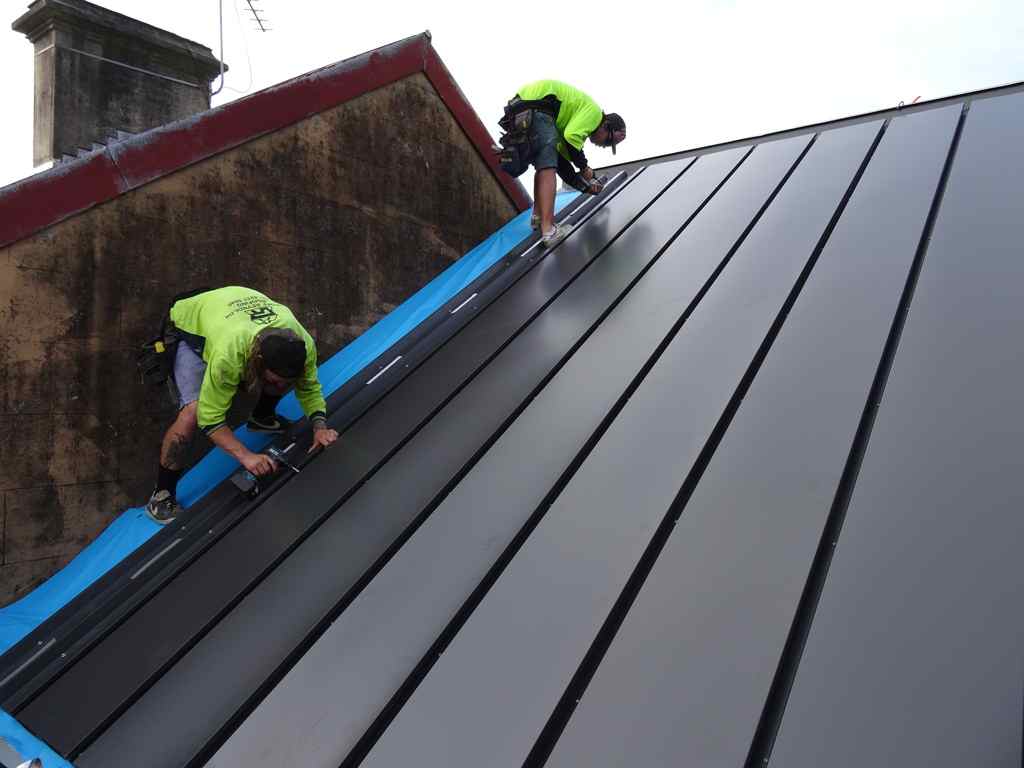A small terrace house in the inner Sydney suburb of Glebe is hosting what is believed to be the world’s first building integrated solar system that generates electricity as well as heat.
 The array combines thin-film solar PV and solar thermal technologies into a steel sheet roofing product produced by Australian steel manufacturer Bluescope, with assistance from the Australian Renewable Energy Agency.
The array combines thin-film solar PV and solar thermal technologies into a steel sheet roofing product produced by Australian steel manufacturer Bluescope, with assistance from the Australian Renewable Energy Agency.
The top layer of the roofing product (pictured) generates electricity in the same way as solar PV modules – although it uses thin film technology for less weight and thickness – while heat is trapped and distributed between the two layers for use in water and space heating.
The BIPVT installation is being hailed as a product that could one day be sold on Australian rooftops, although Bluescope is quick to point out that won’t be anytime soon. It has, however, said in the past that it feels it will be a cost competitive product for homes and businesses. But more work needs to be done in understanding supply chains and manufacturing costs before it is launched on the market.
Still, ARENA, which is facing closure from Tony Abbott’s ultra conservative government, was happy to promote the product, and the result of a $2.3 million grant for the $5 million project.
“Today we are witnessing an exciting new technology solution moving from the lab to be prototyped on everyday Australian rooftops for the first time,”ARENA CEO Ivor Frischknecht said in a statement.
“The old corrugated steel roof on this house in Glebe has been completely replaced with the first integrated photovoltaic (PV) thermal system in Australia, generating reliable renewable energy for the residents. A tile roof in the Illawarra region has also been replaced with the integrated PV system, demonstrating its versatility.
“In addition to PV panels, an innovative thermal duct system warms and cools air to supplement air conditioning in the homes. These first installations are an important step as the technology moves towards commercialisation and cost competitiveness with conventional rooftop PV.”
Frischknecht said the system had been designed to provide a low cost system that would reduce installation and energy costs, as well as peak demand pressures on the grid.
BlueScope is trying to reduce system costs through improved PV modules and roofing designs, reduced packaging and transport, improved building energy efficiency and easy, low-cost installation.
When the project was announced in 2012, Bluescope said the building integrated photovoltaic market was expected to increase 10-fold across the globe in coming years and become a key part of new construction, and even building retrofits.
Bluescope’s head of coating product development, Dr Troy Coyle, told RenewEconomy in 2012 that that innovation in designs, and incorporating energy production was a key part of the future market. “That is where the roofing industry is heading,” she said.
“The market motivator is energy reduction, and the motivator for integration into rooftop design is a reduction of material costs and in building heating costs,” Coyle said. “That way we can have it all done in one.”
It could also be used in retrofits. A new roof deck above the existing roof surface can incorporate solar cells, and air then flows in the duct created under the new roof surface. This air flow will not only help cool the solar cells during warm weather, improving generation efficiency, but it will also help to heat and cool the building. Warm air generated in winter is used for heating, and as heat is radiated from the cells on summer nights, cool air is then supplied to the building, increasing overall energy efficiency.
Bluescope sees this technology being applicable in the residential, commercial and industrial markets.
The opening was attended by the Bob Baldwin, the deputy for Industry Minister Ian Macfarlane. “This a great display of Australian ingenuity and an example of industry leveraging government funding to make breakthroughs that may lead to advanced manufacturing and export opportunities,” he said in a statement. Next month, Baldwin’s party will introduce legislation to close ARENA, the agency that made this funding possible.








